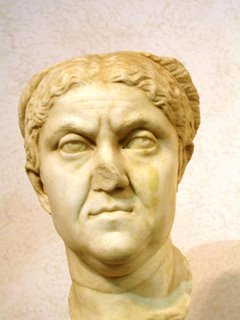Reading a Roman Portrait

I remember when Mother had her sculpture done. She spent hours making sure her hair looked just as though she hadn’t spent hours on it, choosing a simple style with no fancy curls or wire reinforcements. She spent quite a bit of time in front of the polished metal mirror simply gazing at her reflection. When I asked why she did this she told me she was making faces. There didn’t seem to be much variation in her expression from one moment to the next, but I didn’t wish to mention my observation. She said she was trying to convey a sense of gravity and sternness, and that this would come across in the lines upon her forehead and in her furrowed brow. She paid extra attention to her mouth, making sure her smile was just right. She wished to show dignity and mercy at the same time, and eventually worked her face into a curious half-smile that brought out the heavy lines in her cheeks. The overall effect was one of confusion, the upper half of Mother’s face conveying one message, the lower half another.
I have the habit of being much too curious and forward for my own good, and this usually gets me into trouble. Nevertheless, I ventured to ask Mother if she would have the sculptor make her portrait with the ears more even than her own. She has always been rather conscious of the fact that her ears are not level with each other. However, she replied forcefully that she wished to be portrayed exactly as she looked, right down to her sagging skin and the lines in her neck. She wanted no alterations or fanciful “stylistic choices.” It was a new fashion, she said, to look like a normal person in your portrait, to look as though you had lived a bit. Since Father was the most successful man in the area at the time, Mother wished to look as though she was worthy of him. The lines of her face would tell all who visited the front room, whether just to take a rest from the heat of the summer or to meet with the head of the household, that she had greeted many guests and entertained many important people in her day. The knowing half-smile would show that she was a welcoming and understanding hostess, able to balance her children and her demanding social obligations with skill.
The experience made me contemplate the preservation of my own memory someday through a funerary sculpture. Mother had thought so hard about how future generations of people would think of her, about how much they might be able to read from her portrait. We survive forever only through memory, and she wished to be remembered for her best features. But only features that she could truly claim as hers. It is difficult to imagine the people of the future looking at her carefully constructed marble face to see the person that was so dear to me. Perhaps in the future the people will look at her lined face and her sunken eyes and think her ugly or old. Perhaps they will look and think of her style of hair as odd or completely out of fashion. Perhaps they will think her overly masculine looking. Perhaps they will see her simply as a sculpture and not a person at all. But it is certain that her countenance will be contemplated, and her memory will therefore live on. And as long as there is memory, there is life.

1 Comments:
The D Guy
Your writing is amazing,love the part about the ears. Read the whole sanctym thingy again. It was very fun. Still haven't got the reciep for coffee from you. Maybe you could ask one of the venders. I promise to make it for you.
Post a Comment
<< Home